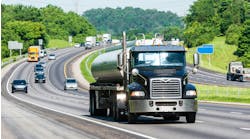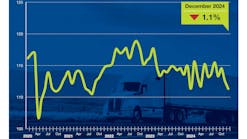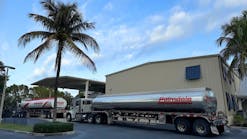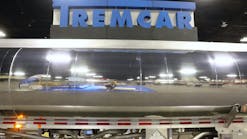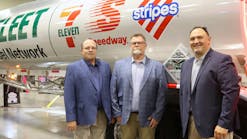The United States is the Saudi Arabia of natural gas.
With that bold statement, Richard Moskowitz, American Trucking Associations vice-president and regulatory affairs counsel, launched into a presentation on the relative merits of natural gas as a vehicle fuel. Moskowitz spoke to members of National Tank Truck Carriers during the association's 63rd Annual Conference May 22-24 in Baltimore, Maryland.
Energy security and independence are key concerns that are driving the growing interest in natural gas. “The United States consumes more than 19 million barrels of oil a day, and about half of it is imported,” Moskowitz said. “Many of the countries that supply oil to us don't seem to have US interests at heart.”
Natural gas seems to offer an opportunity to break our dependence on foreign oil. Based on currently proven reserves, the United States has — at the very least — a 200-year supply of natural gas, and it works just fine as an alternative fuel for a diesel truck engine.
“This is a fuel that we can access today as a replacement for diesel,” Moskowitz said. “The US trucking industry currently consumes 35.6 billion gallons of diesel annually at a cost of around $137.8 billion,” he said. “It is the industry's highestoperatingcost.”
Less expensive
Besides being a plentiful, domestically supplied fuel, natural gas is $1 to $1.50 cheaper than diesel on a Btu-equivalent basis. That means it could give truck fleets a less expensive option to diesel.
A comparison of operating costs shows that natural gas could generate around 30% savings over diesel. The comparison is based on diesel at $4 a gallon and natural gas at 2.50 a gallon, and it accounts for the lower fuel efficiency of natural gas. For a fleet running an annual average of 100,000 miles per tractor that means $18,435 in fuel savings with natural gas.
Particulate and NOX emissions are comparable between diesel and natural gas engines. However, natural gas engines do reduce greenhouse gas emissions. CNG provides a 28% reduction in CO2, and LNG offers an 18% drop. Methane venting could pose an issue for LNG engines.
That doesn't mean natural gas comes with no downside. The biggest negative at this time is refueling infrastructure in the United States. There simply aren't enough retail locations that offer compressed and/or liquefied natural gas as a vehicle fuel.
Compressed natural gas (CNG) is probably the easiest to handle, according to Moskowitz. However, current CNG fuel tank configurations only carry enough for a 300- to 350-mile range. Liquefied natural gas (LNG) (which is stored at around -260°F) can provide up to a 750-mile range, but refueling personnel would need to wear protective clothing and have special training. LNG fuel tanks also are more expensive than CNG tanks.
Two options
Truck operators currently have a choice of two types of heavy-duty natural gas engines that are based on diesel engines. One uses spark ignition, while the other employs compression ignition.
Spark ignition natural gas fueled engines now are available in seven- and nine-liter ratings and 250 to 320 horsepower. A 400-hp 12-liter spark ignition engine should be on the market in 2012, according to Moskowitz. Compression ignition natural gas engines are based on a 15-liter platform and are rated at 400- to 550-hp.
Spark ignition engines have a fuel economy penalty of 7% to 10% compared to diesel, while the penalty for the compression ignition engine is more or less 1%. It should be noted that the compression ignition engine is a dual-fuel system that also uses diesel in a 1:20 ratio.
Neither a diesel particulate filter nor selective catalytic reduction system are needed with the spark ignition engine. The compression ignition engine may require both.
These engines aren't inexpensive. The spark ignition engines come with a price premium of $30,000 to $40,000, according to Moskowitz. The compression ignition engine costs around $75,000 more than a comparable diesel-fueled engine, and the premium could jump to $90,000 with extra fuel tanks.
Either CNG or LNG can be used in these engines, but buyers need to consider the weight penalty of each natural gas variation. Five 15-gallon CNG fuel tanks (enough for a 330- to 350-mile range) will add about 1,200 pounds to the vehicle weight. Two 119-gallon LNG tanks (good for up to 750 miles) will add 1,000 pounds.
Maintenance is another cost factor. Mechanics must be trained to service natural gas engines, and the instruction program runs 25 to 60 hours for each mechanic. In addition, maintenance shops will have to be retrofitted to deal with methane releases, and that will cost $100,000 to $200,000 per facility, according to Moskowitz.
The challenges can be overcome, and natural gas can displace diesel in some fleet operations, Moskowitz says. As the natural gas fueling infrastructure is built up across the country, more fleets will see the appeal of natural gas as an alternative to diesel.
“Our policy at ATA is that natural gas should remain a voluntary alternative fuel,” Moskowitz said. “The trucking industry supports financial incentives to encourage trucking companies' use of natural gas, provided those financial incentives do not reduce money allocated to the Highway Trust Fund. The trucking industry (also) opposes government actions that artificially increase the cost of diesel fuel compared to other transportation fuels.” ♦

